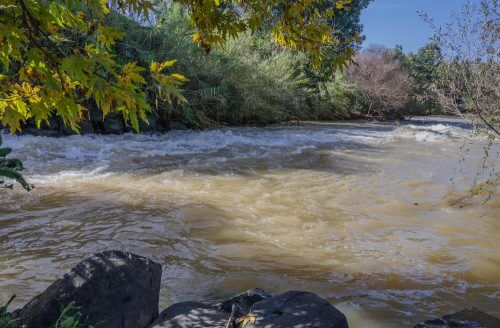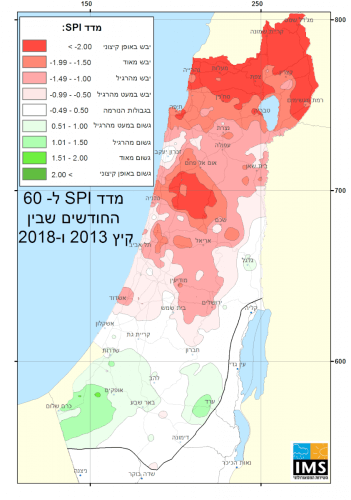Climate change is happening here and now also here: the sea water in the eastern Mediterranean has warmed in the last 30 years by 3 degrees Celsius; A new report by the Israeli Meteorological Service recently revealed that there is a clear trend in Israel of an increase in the minimum, maximum and average temperatures. The general average temperature increased by 0.65-0.5 degrees Celsius every decade, that is - an increase of almost two degrees in the last 30 years. All of these caused the Jordan River to dry up and phenomena such as the mouse
By Dr. Adi Levy, Angle - Science and Environment News Agency

Climate change is not perceived by many of us as something that threatens us here and now, but as a black cloud that hovers far on the horizon that may cast its shadow on us in the distant future. "Our grandchildren will take care of it," talkbackists often write in response to studies that deal with the issue.
Forecasts and models of climate scientists show different scenarios for warming and rising sea levels until the year 2100, but we already know today that the average temperature in the world has risen since the beginning of the industrial revolution by almost one degree Celsius. The increase in the frequency of extreme events that include heat waves, droughts and fires alongside the intensification of storms and the decrease of very large amounts of rain in a short time (which leads to floods, inundations and mudslides) can already be seen around the world today.
These changes are happening here and now also here: the sea water in the eastern Mediterranean has warmed in the last 30 years by 3 degrees Celsius; A new report by the Israeli Meteorological Service recently revealed that there is a clear trend in Israel of an increase in the minimum, maximum and average temperatures. The general average temperature increased by 0.65-0.5 degrees Celsius every decade, that is - an increase of almost two degrees in the last 30 years.
A study recently published by scientists from the Hebrew University, from Switzerland and Australia, found that the increase in temperature observed in our region reduces the availability of precipitation, and those that do rain tend to do so with a higher intensity, which leads to floods and inundations, as occurred more severely last June and claimed many lives. For the past five years, a drought has prevailed in the north of the country, with the drought index of the meteorological service indicating values ranging from "very dry" to "extremely dry" in these years in the entire northern region, especially in the eastern Galilee and the Golan.
A drier winter than usual
According to the data of the meteorological service, the winter of 2017-18 was also drier than usual in the region of the Finger of the Galilee and in the north of the Golan, areas from which a large part of the northern streams are fed. The accumulation of five years of parking, together with a constant increase in the population and an increase in our water consumption and that of our neighbors, led to the depletion of water sources in the north and especially weak flows in the Golan streams and the sources of the Jordan which even led to the closing of streams to the public.
The outbreak of leptospirosis in the northern rivers, caused by the bacterium leptospirosis, is apparently the result of those very low flows that reduce the water turnover in the streams and allow animal excrement containing the bacteria to accumulate in the water sources and increase the concentration of bacteria in them, which also increases the chances of infection in the disease of those who bathe in the streams. According to the Ministry of Health, as of August 14, at least 14 travelers to the line are infected and close to 50 are suspected of having contracted it.
The mouse disease is not alone, various studies from around the world indicate a clear connection between the rise in temperature as a result of climate change and the spread of diseases that are transmitted by mosquitoes. Such diseases also reach areas where they were not before and examples of this can be seen in the spread of West Nile fever in Southern and Eastern Europe, the Zika virus in the Americas and even malaria and dengue fever. But it is not only about diseases that are transmitted by mosquitoes, but also the possibility of contamination of drinking water by sewage due to flooding, which may spread diseases that are transmitted by drinking water, such as cholera.

The drought index in Israel in the last five years
Nature's right to water
So that we don't experience an outbreak of this kind next year as well, we need to actually implement nature's right to water. Since we have no control over the amount of rain that falls and the general trend expected in our region in the coming years as well is a multi-year decrease in the amount of precipitation, in order to allow more water to flow in the streams, we need to reduce the pumping in the source areas, pump the water for irrigating agricultural crops down the stream instead of upstream and switch to irrigating each crop with effluent that can be done. In crops with high water consumption where it is not possible to switch to irrigation with effluents, one should seriously consider switching to crops or varieties that require less water and are better adapted to the climate change in our region. Vaccinating the herds of cattle that graze in pastures, limiting their access to natural water sources and reducing the presence of rodents next to farms engaged in raising animals will reduce the risk of a repeat outbreak next summer and the ones after that.
The desalination plant in the Western Galilee, the establishment of which was approved very recently and is expected to start operating within a few years and to flow desalinated water to the north as well (while allowing for the reduction of the use of natural water sources) is a good but short-term solution. We should all realize that climate change is here to stay.
In order to reduce the future effects of climate change, we must dramatically reduce greenhouse gas emissions through weaning off fossil fuels and switching to renewable energies alongside extensive energy efficiency in the private, public and industrial sectors. A significant investment already today in preparing for the damages of climate change through preparing for sea level rise, reducing flood damage, removing carbon dioxide through technological means or through massive planting of forests and the development of resistant agricultural crops will reduce the future damages that are yet to come.
The author is the scientific director of the Israeli Society for Ecology and Environmental Sciences.
